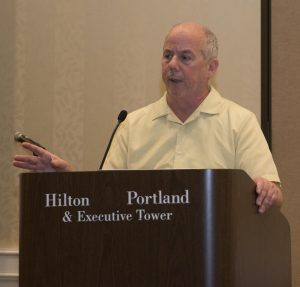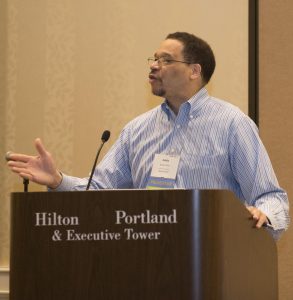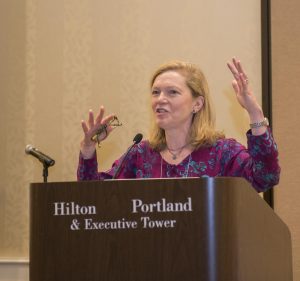HCH still exists as a distinct service within health centers and other service systems. The key questions posed to the presenters and participants of the HCH Pioneers Session were:
How has HCH interacted with mainstream service providers such as hospitals, other health centers, behavioral health providers, public health departments, Medicaid and other payers, and health profession schools? Has HCH affected other justice movements, and if so, how? Has HCH improved the health of the homeless population as a whole? If yes, how? If not, why not?

John Parvensky, executive director of the Colorado Coalition for the Homeless, spoke of his 30 years of work with the Coalition. “We started out in places that weren’t designed to provide medical care, some that were barely habitable. We didn’t think we’d have to create institutions of care.” He showed “before and after” photos of the Stout Street Clinic and spoke of how they had started with a staff of six people and they now employ 600 staff members, and of the challenges of “how to keep the philosophy of service, that culture of client-centeredness” with that sort of expansion. He worked with Mitch Snyder and others who advocated for McKinney funding for HCH and showed photos of Comic Relief[1] and Robin Williams. “Health care as a right, not as a privilege, is what we’ve had from the beginning.”
As the movement has gone along we’ve been able to make the facilities more dignified, more appropriate, more trauma-informed.” Parvensky referred to Jean Hochron’s statement years ago that “she hates what they did, she hates what Baltimore did in building a new clinic, she hates what Boston did, and I agree. We didn’t think when we started out that we’d need to establish institutions that would last beyond a few years in order to address the issue. But we came to terms with, in dealing with Health Care for the Homeless, you’re not dealing with a person who just doesn’t happen to have a safe place to be tonight, but the underlying conditions that led people in and out of homelessness, and their ongoing needs.
When advocacy wasn’t enough, we figured out how to do it ourselves—including housing.” Two years ago they were able to build a freestanding clinic using lessons learned across the country—integrated care in one building and with 78 housing units above them. They now have 2,000 housing units dedicated for families without homes, which include onsite health care services. “We’re still struggling with how to bring the HCH model into the Housing First model when people don’t necessarily want you there. The advocacy piece is central to the Council role.
He concluded by stating, “The road ahead is darker than I’d hoped for 30 years ago. I’m more discouraged. The level of acuity of the issues we’re seeing keeps increasing. The availability of housing—as much as we’ve been able to create—keeps dwindling. We have our work cut out for us. And unless we continue that advocacy focus while demonstrating that what we do makes a difference, makes an impact, we’re not going to be successful.”

Ed Blackburn, executive director of Central City Concern (CCC) in Portland, Oregon, spoke of how CCC is not typical of most HCH programs, since they started out as a housing agency back in 1980. “We had many SRO hotels. They were being torn down in the 1980s and street homelessness was rising. They were pretty horrible places actually. The city formed a coalition to save some of these. They went into these places with baseball bats and took them back from drug dealers and occupied them, stabilized the buildings, and brought homeless people back in. The things that we did to survive and to develop, we’d never do now. There’s something about going through the struggle in the early days—you did it because of incredible dedication, vision of people, risk-taking, but also this creativity—it had to be endless. You had to really figure out from one crisis to the next.”
Blackburn also stated that, “Going into the health care business almost put us out of business. We hired people in recovery to help. We now have 850 employees and half self-identify as being in recovery from addictions or mental health.” He spoke of the importance of working with anti-poverty programs. “Continue to serve people in homelessness while working to end homelessness. People know now that when you get people into better housing, they get better.”
CCC partners with Oregon Health Sciences University, offering medical school rotations, and with 16 other health science programs. They are currently working with the largest managed-care agency in Oregon, Health Share of Oregon. Because they came into this from the housing perspective first, they’ve been working on ending homelessness from the very beginning.
This advocacy thing and this political thing is really a strength we have in the history of HCH. We can’t give it up. I think we need to be more active on the ending homelessness front as we continue to serve people in homelessness—because that’s where the hope is. That’s where the advocacy needs to be. We know that people get better when they get housing at a higher rate. There’s real hero work going on for people on the streets and in the shelters. And I have no doubt that just the compassion and the human contact, but also the clinical skills are resulting in better outcomes for people. But if we can get people into housing it’s going to get better yet… This (NHCHC) is a terrific advocacy organization. There’s more passion in this organization than almost any other we belong to.

Bobby Watts, executive director of Care for the Homeless in New York City, spoke next. “We did not want to become an institution; we did not want to become an organization that continues on.” He spoke of the ongoing tension between wanting to keep specialized homeless services versus mainstreaming, and the importance of changing the health care system and FQHCs to help them be more effective at serving homeless populations. He’s come around to wanting to do both, but he tends now to work more on mainstreaming changes. “Health Care for the Homeless is a distinct service, a specialized service, serving a distinct population with specialized needs. To what extent should we continue to enhance our specialization, or should we try to make sure that homeless people are served by the mainstream health center?” Mr. Watts has come to the conclusion that HCH should do both. He also spoke of joint programs between hospitals and HCH programs, especially programs trying to address the problem of patients with frequent emergency department visits, and also medical respite which was “innovated as a model through HCH.” He pointed out that mainstream health care systems are seeing the need for this through the ACA as a way to decrease unnecessary hospitalizations and repeat emergency department visits. Watts concluded with:
“Are we improving the health of the homeless?” is a perverse question. It is like asking, “Are we improving the health of people in human trafficking?” I don’t know if we’re improving the health of the homeless population as a whole. The big thing is SDH (social determinants of health). Until we can make a difference in SDH, including housing, we can’t really make a dent in their health. We’ve come a long ways. We’ve helped to move the health care system. But we have unfinished work to do. It’s good to reflect on the past, how we’ve moved the needle. But we need to focus on people trapped in homelessness and how to end their captivity.

Heidi Nelson, chief executive officer of Duffy Health Center on Cape Cod, spoke of how Duffy was funded in the second wave of HCH in the early 2000s. She talked of seeing herself as “a mainstream provider, a hospital administrator” and that she found herself working in a setting where “everyone was a doctor or nurse or social worker or had gone to seminary but decided not to be a minister—or had been a priest—they all had a grassrootsy feel.” She highlighted the fact that “HCH is at the nexus of many, many programs and systems: mental health, substances, homelessness, HIV/AIDS, housing, refugee, veterans. There are so many different meetings and it is so important to be at all these tables.” She also spoke of the Treatment for Homeless Persons (THP) grant through SAMHSA. “We started that program—the National HCH Council—started it.” In terms of teaching the mainstream how to care for homeless people, she said it is “‘Pie in the sky’ thinking we’d teach them and then we wouldn’t need to teach them anymore—it isn’t true. We try to bring them into the big house of HCH. We need to stand up and say ‘you aren’t doing it right, but in a really nice way.’”
At the conclusion of the panel presentation for this section of the HCH Pioneers session, John Lozier stated that “something we have not spoken to, perhaps just lip service, is the role of consumers in our work. That’s an important piece I don’t want us to overlook.” Then he opened it up for anyone in the room to speak.
Mark Rabiner, formerly with Dr. Brickner’s Department of Community Medicine at St. Vincent’s Hospital, talked about the evolution of the model of care. “The HCH model, which is outreach-oriented primary care delivered by teams, is not really a health care model. And I think that is one of the factors of what we do in Health Care for the Homeless. We have this utopia of what we want, but we tend to forget that we have to fit within the reality of what health care is. The vision is health care for everyone. And the value is excellent care given with dignity and compassion.”
Michael Cousineau, a professor at the USC Keck School of Medicine and the founding director of Homeless Healthcare-Los Angeles, addressed the changes in our health care system, including the focus on the patient-centered medical home. “There’s a lot of money being made on things we’ve been doing for 30 years.” The challenge to the group is “how the HCH model should be changed to fit into the new system with its emphasis on health care outcomes, of proving that what we do is making a difference. We’re not going to be exempted from this. But I think we’re in a position of saying, ‘Well, what are the outcomes that are appropriate for this population?’ I think we have to be in the front of that argument as advocates to try to put that argument forward—it’s got to include housing, social services, employment—things that aren’t getting discussed very much when we talk about outcomes in health care.” In a follow-up conversation I had with Cousineau, he spoke of how the HCH program was supposed to have a beginning and an end. “I feel like we’re still putting Band-Aids on this problem—I’ve never seen it this bad.” He also pointed out that the St. Vincent’s HCH model that Brickner and others started was very much hospital-based care and outreach, while the HCH model developed in L.A. and some other cities was more community-based.
Marion Scott, former director of the HCH project of the Harris County, Texas, Hospital District, spoke of the creative and innovative use of resources and the importance of networking:
What we had back then—it was remarkable what we did with what we had. Early on we talked about rescuing and fixing—that is what we did. Availability does not equal accessibility for homeless people. We’ve moved now to empowering consumers and liberating providers—that allows them to do what they need to do to provide the total health care—including the social determinants of health to provide a continuum of care. The challenges of moving from silo to team-based care. There are still challenges, but we can see improvements that come perhaps from the HCH model. Continuum of care and care coordination has become important. Networking is a strength of HCH. There’s always been that element. We can call someone across the country—tell these stories from one program to another. We use the HCH central expertise. The importance of mentors, supportive family members in a way for our work, has to continue, that spirit has to continue, telling stories from one program to the other, and using available HCH expertise is going to be important as new programs begin to evolve and operate.
Stephen Kertesz, a physician formerly of Boston, now from Birmingham, pointed out that the VA has embraced the HCH group wisdom with their H-PACTs (Homeless Patient Aligned Care Teams). He also spoke of legislative threats to the future of HCH. “The 1996 consolidation legislation of community health clinics doesn’t include specific wording protecting homeless services. In 330(h) there is no mandated care for the homeless.” He’s watched the dismantling of homeless health care services in Birmingham, and he’s witnessed firsthand the effects of that on the care of people without homes. “Doing the good work that you do is 100% optional. And I don’t think that that should be our future.” In a follow-up e-mail and telephone conversation that I had with him, Kertesz addressed the problems that have recently surfaced in terms of the Birmingham HCH. He wrote:
Once you read what we have experienced in Birmingham (and the lessons I derived from talking with several people who have observed the HCH program over decades), you’ll see that I feel like homeless persons are at high risk of being abandoned by the very grant-funded program intended to help them. Whether HCH grantees truly seek to serve homeless people by tailoring their service model and maximizing care options for people who are homeless, or whether they minimize exposure to the population by providing them with poorly-resourced care, is simply a matter of conscience of the agency.
In my telephone conversation with him, Kertesz voiced a concern that people feel that there is no longer any problem to fix, that “the bad man is gone,” and that no one is acknowledging that there are serious systemic issues in terms of oversight of HCH programs, and that quality, compassionate Health Care for the Homeless is being eroded. The other thing that he mentioned towards the end of our conversation was that the people who tend to be in the inner circle of the NHCHC can tend to reinforce the status quo of interests and direction of the Council, which serves to alienate many other people who work within HCH across the country.
Travis Baggett, a physician from Boston HCH Program, stated, “Our understanding of addiction was much different 30-40 years ago than it is now. We saw it as more of a character problem when we started out. Now there’s an evolution in our understanding of the biological realities of addiction. We’ve been at the forefront of this—we can be leaders of the move to integrate addiction services into what we do.”
Since no one in the Pioneers session specifically spoke to the role of consumers in the work of HCH, I sought out additional input from consumers who participated in the HCH Conference and Policy Symposium. From a conversation I had with Willie J. Mackey, CAB[2] member from Palo Alto, CA, he said, “Be sure to tell people that homeless folk need jobs, employment with regular health insurance—not just public assistance—that makes you lazy and it eats your self-esteem away. All these people [sweeping his hands towards the registration table and some of the Council members standing around] mean well. They’re compassionate people, but it’s all ‘over there at a distance, and I don’t really want to know or listen to what it’s like to be homeless.’”
Art Rios, from Portland, Oregon, who received a Consumer Advocate Award, said in his acceptance speech, “Some of the biggest support I have is from the other CAB members. He read a powerful poem, “Hello, My Name is Homeless,” that he wrote. I contacted him after the conference to ask if he would be willing to send me the full poem and to allow me to include it in this report, and he agreed. Here is the full text of the poem:
Hello my name is Homeless
by Art Rios, Sr.How did I get this name? it could be from many reasons
Addiction, mental illness, poverty, poor education, medical problems, criminal history, lost wages, lost job
Hello my name is Homeless
No shower, no food stamps, no money, no shelter, no blankets, no self respect for my self, because I can do better.
Hello my name is Homeless
But I will sleep on the sidewalk tonight because I know I have the power to get up tomorrow and do it all over again.
Hello my name is Homeless.
In a conversation I had with Amy Grassette, a consumer from Worcester, she applauded the work of John Lozier and the Council in working towards inclusiveness of consumers in leadership roles. She states, “Over the 12 years I’ve been involved, I’ve seen that grow in importance steadily and from everything I hear from the different committees, it seems to be a strong focus. There was a time that there were no consumers on Council Committees or on the Council’s Board of Directors. That has completely changed.” She also pointed to NCAB involvement in research, such as a recent study on violence published in a journal.[3]
[1] Comic Relief was a series of 8 HBO telethons starting in 1986 that raised funds for the member agencies of the National Health Care for the Homeless Council.
[2] A CAB is a Consumer Advisory Board, a mechanism that numerous HCH grantees use to provide consumer input into agency governance.
[3] Molly Meinbresse et al., “Exploring the Experiences of Violence Among Individuals Who Are Homeless Using a Consumer-Led Approach,” Violence and Victims 29, no. 1 (February 1, 2014): 122–36, doi:10.1891/0886-6708.VV-D-12-00069.